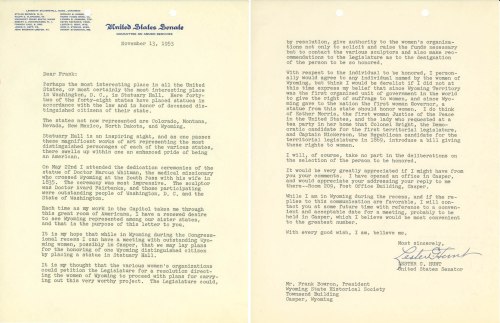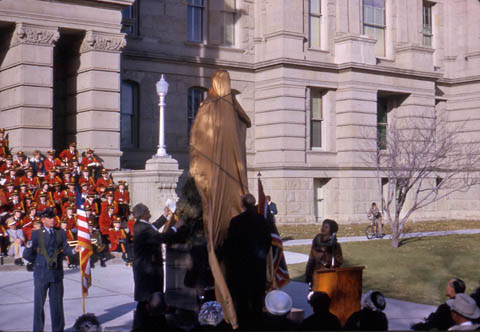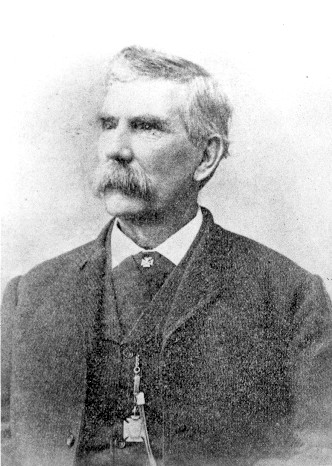On November 5, 1924, Wyoming made history by electing Nellie Tayloe Ross governor, once again shattering a glass ceiling for women. The state that led the way in women’s suffrage became one of two that year to elect a female chief executive.

Governor Nellie Tayloe Ross seated at her desk in the Governor’s Office, Wyoming State Capitol Building, 1924-1926. Ross was the first female governor in the United States. She and Ma Ferguson of Texas were both elected on November 5, 1924, but Ross took office before Ferguson.
(WSA Sub Neg 2260)
Just over a month before, Nellie had been just another first lady, albeit a very involved one. Her husband, Governor William B. Ross, had bucked the Republican stronghold on Wyoming politics and was elected Governor in 1924, despite a lack of support from Senator John B. Kendrick of Sheridan, Wyoming’s Democratic powerhouse. Nellie was her husbands constant helper, companion and confidant, even writing and refining speeches for him.

Governor William B. Ross standing on the steps of the Governor’s Mansion following his inauguration. His wife, Nellie, was offered the Democratic nomination for governor following his unexpected death in 1924.
(WSA Bristol Collection 31-8)
In September 1924, she accompanied him on a tour of the state to promote his plan to introduce a proposal for constitutional amendment for a mineral severance tax. Following his well-received speech in Laramie on the 23rd, William came down with what he thought was a bad case of indigestion. By the time a doctor was called the next evening, his appendix had ruptured and there was little the specialists from Denver could do once the sepsis set in. William hung on until October 2, with Nellie at his side as often as the doctors would allow. Nellie was devastated by the loss.

Nellie was a considerate corespondent and dutifully sent many hand written thank you notes. This one was sent to Gertrude Hicks in thanks for flowers for William funeral. “You, perhaps, can understand something of the desolation his going has left in my heart – Truly it is unspeakable.”
(WSA H64-36)
William was buried in the family plot in Cheyenne on the 4th. Following his funeral, chairman of the Wyoming Democratic Committee Dr. J.R. Hylton, called on Nellie to offer his sympathies and a novel opportunity. How would she like to run for governor to serve out her husband’s term?
Almost as soon as Frank Lucas took over as acting governor, he had called for a special election for governor as statue mandated. There was no time to lose since the general election was coming up on November 5. Including the governor’s race would save the state time and money. But that meant that both parties had only one month to produce candidates and organize a campaign. Who better to take up the Democratic platform than Nellie?

Nellie’s supporters were quick to point out that it would be an honor for the “Equality State” to be the first to elect a woman as governor.
(WSA Cheyenne Daily Leader November 3, 1924)
Against her brother George’s council, Nellie turned down the offers of a comfortable position as a clerk or even State Librarian and accepted the party’s unanimous nomination on October 14. Still in mourning, Nellie declined to campaign for herself. But this did not stop her supporters from taking out newspaper advertisements and publishing literature on her behalf. Even Senator Kendrick endorsed her campaign saying:
No one who has even a passing acquaintance with Mrs. Ross would for a moment doubt her qualifications to act as chief executive of this state. She is highly educated, intensely practical, and is inherently conscientious in the fulfillment of every responsibility. It is a well-known fact that no husband and wife ever lived in our state’s capitol whose relationship was more intimately devoted, and there has perhaps never been an official of the state whose wife enjoyed more fully his complete confidence in his every public act than Governor Ross. She was his chief counselor, and, as he often said, his most severe critic, and his record of service clearly indicates the wisdom of her counsel. — Cheyenne Daily Leader October 29, 1924

Senator and former Governor, John B. Kendrick endorsed Nellie’s campaign for governor.
(WSA Cheyenne Daily Leader October 29, 1924)
Despite running as a Democrat, Ross, like her husband before her, made it clear she was her own woman and would not necessarily follow strict party lines.
I am not unmindful of the great responsibility this office entails and… I shall expect and feel in duty bound to make my own decisions in every case… Under no circumstances would I have accepted this nomination had not my familiarity with and my interest in my husband’s work given me an understanding of the problems of the office and a reliance upon my own ability to assume the responsibilities laid down by him. — Cheyenne Daily Leader 11/3/1924
She also made it known that she was of a mind with her late husband and would follow his lead in many areas.
Ross had her detractors, though in deference to her recent loss they tended to be more discrete than in most campaigns. On the eve of the election, Edna Bartlett of Cheyenne published a lengthy political editorial in the newspaper addressing what she saw as the unfounded and wrong assumptions of her fitness for office, and the unfitness of women in general for politics.
We want to answer an objection to Mrs. Ross’ election that is sometimes heard: “I am afraid she isn’t strong enough.” Of course those who know Mrs. Ross personally don’t pay any attention to this: we know that her political enemies have to think of something to say against her election and it is absolutely impossible to say anything against the lady herself, they are forced to attack her strength, sometimes under a pretense of solicitude for her. — Cheyenne Daily Leader November 3, 1924

Edna Bartlett’s methodical, logical response to many of Nellie detractors pointed out what she saw as the flaws in the logic against a woman, and Nellie in particular, serving as governor.
(WSA Cheyenne Daily Leader November 3, 1924)
Bartlett goes on to counter such arguments as:
– No woman has the strength to be Governor — “if the Governor’s job was moving pianos or making steel or prize fighting we wouldn’t want a woman governor. But the… quality which determines the winner in these cases is endurance.”
– Women are inferior to men in endurance — “Rather the contrary. Ask your doctor [about childbirth]… There is every reason to believe that [Mrs. Ross] has more of the kind of physical strength needed by an executive than many men who have held the office of Governor or who aspire to it.”
– Strength of mental character and spirit — “Read her letter of acceptance and her letter to the women and note in them the evidence of mental and moral strength, how clear-cut her views, how firm her expression of them!”
– Women are all emotional — “Well, we are willing to concede this… and that Mrs. Ross may be, for here is one of her strong points. She is governed by one emotion:… love… The noble emotion of love will keep her clear-headed and steady… Who can doubt that this emotion is her strength and will mean wisdom and justice for the benefit of the whole state?”
On election day, Nellie watched out the window of the Governor’s Mansion as voters filed into the carriage house, a designated local polling place. Her fate was in their hands.

Nellie won the governor’s race in 1924 as the only Democratic candidate elected to a statewide office in Wyoming that year. Her win was much less contested than that of MA Ferguson of Texas.
(WSA Cheyenne Daily Leader November 5, 1924)
In the end, the people of Wyoming elected her by an almost 8,000 vote (55%) majority over E.J. Sullivan. In 1926, she ran for re-election again with a promise of “no pledges except to the people.” She was very narrowly defeated by Frank Emerson. In 1933, she was appointed director of the United States Mint, a position in which she served with distinction as both the first woman and longest-serving (20 years) director.










